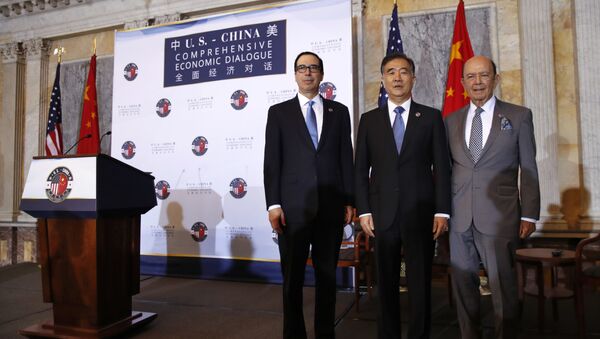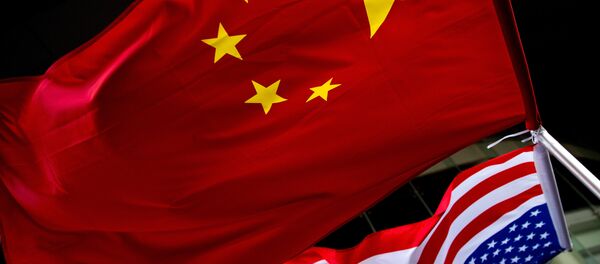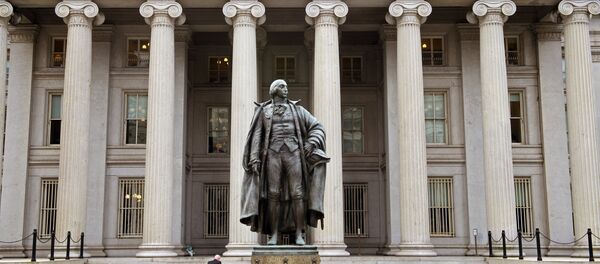Price too high
However, the annual economic dialogue ended with little consensus, as both sides canceled the scheduled press conference following the meeting and no joint statement was released.
"China acknowledged our shared objective to reduce the trade deficit which both sides will work cooperatively to achieve," US Treasury Secretary Mnuchin said in a brief statement released after the meeting.
The lack of progress on bilateral trade and economic issues could be a result of excessive demand from the US side, experts told Sputnik.
"The results of the economic dialogue failed to meet expectations. Personally, I think the main reason is that the asking price from the American side was too high. China has already made promises on a number of concessions on increasing imports from the United States and improving market access for American companies," Jin Canrong, a professor in the School of International Studies of Renmin University in Beijing, told Sputnik.
Following Trump’s first meeting with Chinese President Xi Jinping in April, both sides agreed to advance US-China economic cooperation with a 100-day action plan under the framework of the US-China Comprehensive Economic Dialogue. A 10-point list of initial actions for the 100-day plan was released in May, including a few key areas of cooperation where China would reopen its domestic market to US beef and offer better access to its financial markets for US companies. The United States also lifted restrictions on exporting liquefied natural gas (LNG) to China, which could help boost American exports.
"It seems there is a target to cut the US trade deficit with China by 50 percent in one year’s time. This is only achievable by reducing Chinese exports to the United States, which could cause serious unemployment problems in China. Chinese authorities would never allow that," he said.
Official figures from the US Census Bureau showed that the US trade deficit in goods with China stood at $347 billion in 2016, dropping 5.5 percent from that of 2015. Top import categories of goods from China in 2016 were electrical machinery ($129 billion), machinery ($97 billion), furniture and bedding ($29 billion), toys and sports equipment ($24 billion) and footwear ($15 billion).
At the same time, US exports of services to China expanded to $53.5 billion in 2016, up 10.5 percent from 2015, and 406 percent greater than 2006 levels. The US services trade with China recorded a surplus of $37.4 billion last year.
Better market access
The Trump administration has also demanded improved access to the Chinese market in internet and financial sectors, where US companies have a competitive edge. But the Chinese scholar suggested Chinese authorities could view foreign companies’ dominance in those industries as a national security threat.
But experts from the United States dismissed the notion that US companies’ presence in those sectors in the Chinese market could pose a threat to China’s national security.
"Most of those complaints are artificial. They’re convenient excuses to block foreign competition," Scott Kennedy, deputy director of the Freeman Chair in China Studies and director of the Project on Chinese Business and Political Economy at Center for Strategic & International Studies in Washington DC, told Sputnik.
According to the scholar, participation of foreign enterprises in China’s financial market is under two percent.
"Even if China opens up its banking system or securities market, it would an amazing outcome for foreign market share to reach five percent. I don't think liberalizing that market would lead to an immediate and huge change in market share," Kennedy said.
Rule of global market
One of the biggest reasons behind the massive US trade deficit with China is the shift of global manufacturing to Asia where labor costs are much cheaper. But US companies continued to generate colossal profits in the globalized economy.
Innovative products such as the iPhone helped lift California-based Apple to become one of the largest and most profitable corporations in the world. While the iPhone is produced in China and exported to different countries around the world, including the United States, Chinese manufacturers are hardly the largest beneficiaries of the iconic smartphone’s global success.
According to market research firm IHS Markit, the cost of the 32 GB base model iPhone 7’s components is about $219.8, and the assembly of the iPhone, which takes place in China, costs another $5, bringing its total manufacturing cost to about $224.8. Chinese companies also make the battery, Bluetooth and WiFi components, which together cost less than US$10. More expensive components of the iPhone such as the display and processor are made in Korea, Japan and Taiwan, while China has to import those parts from.
Kennedy, the US expert, acknowledged the trade imbalance between the United States and China is affected by changes in investment patterns and the global supply chain that are not easily adjusted by government negotiations.
But he added that China also employed a great deal of protectionism and a massive industrial policy, which prevented US companies from exporting to the Chinese market as they should be.
"American companies and companies from other countries have difficulty investing openly in China and competing against Chinese companies on a leveled playing field. The American market is far more open than China’s and it is entirely unequal," Kennedy said.
The analyst suggested that the Trump administration tried to fix the trade deficit with China by getting Chinese authorities to set specific goals on trade figures demonstrating it does not have much faith in free market.
"By telling the Chinese government to adjust its policies, the commercial outcome won't be any better for Americans," Kennedy said.
This approach was the exact same as the Clinton administration tried to use against Japan in the mid-1990s, which failed and was eventually abandoned, Kennedy pointed out.





